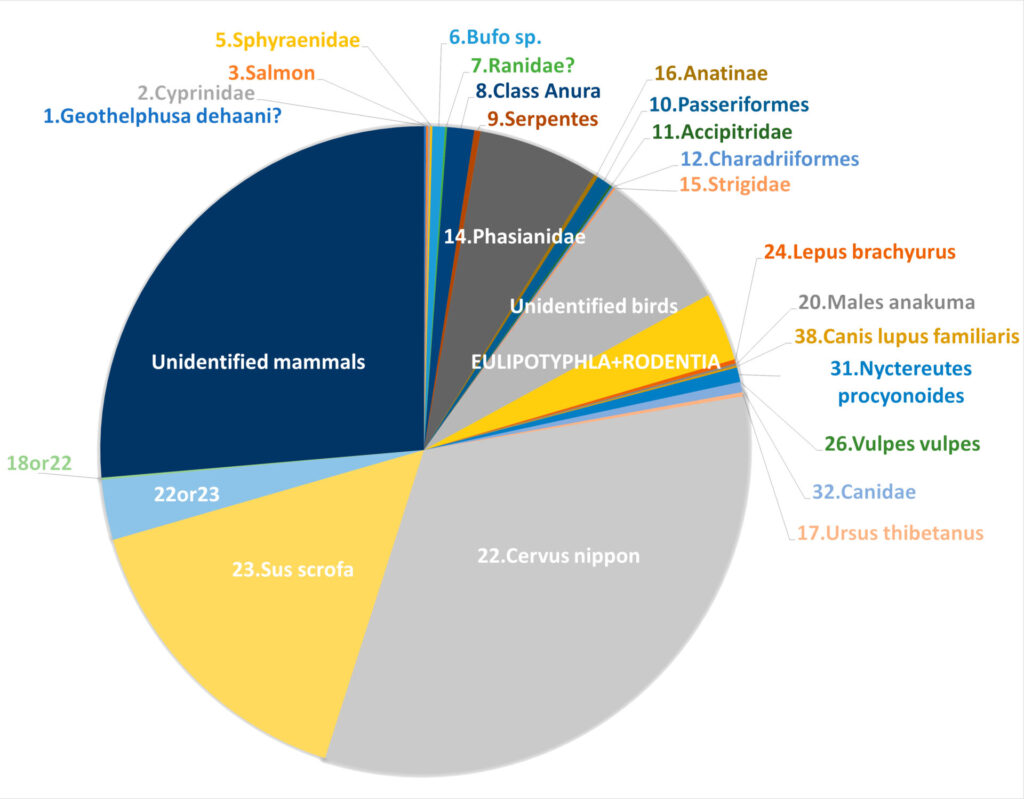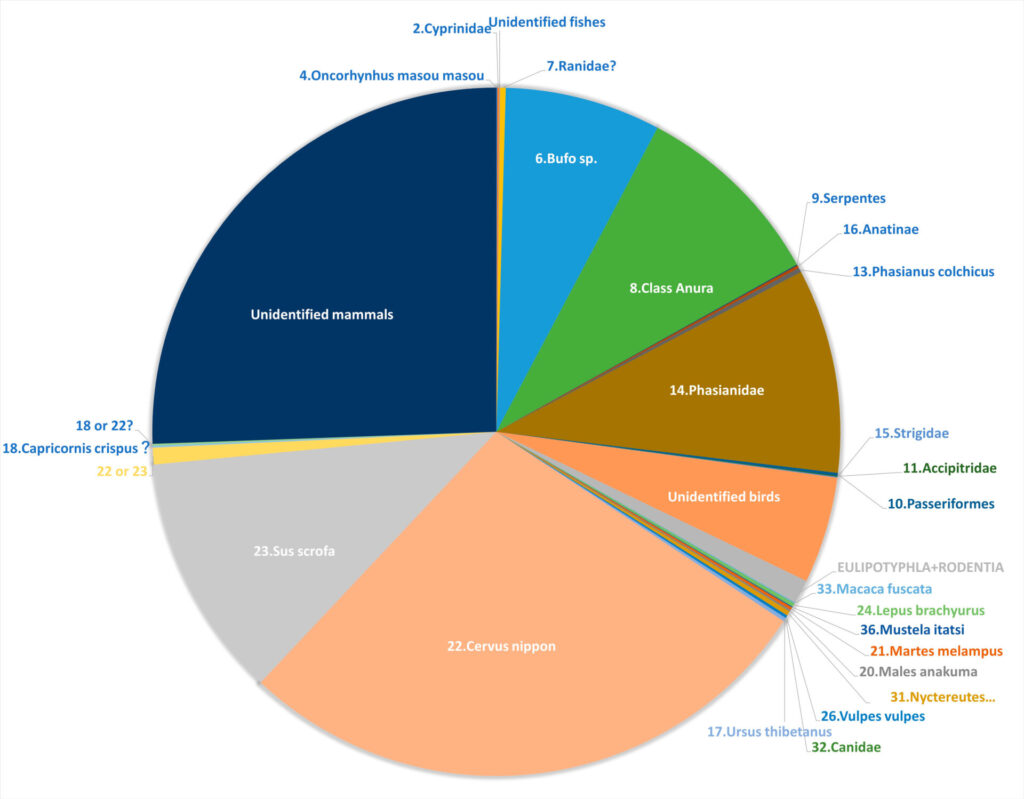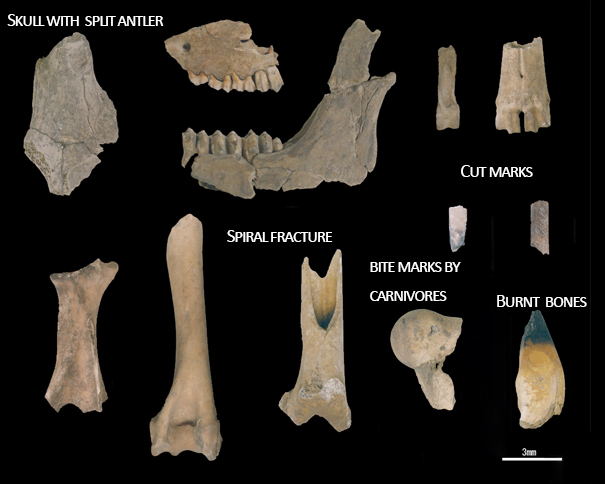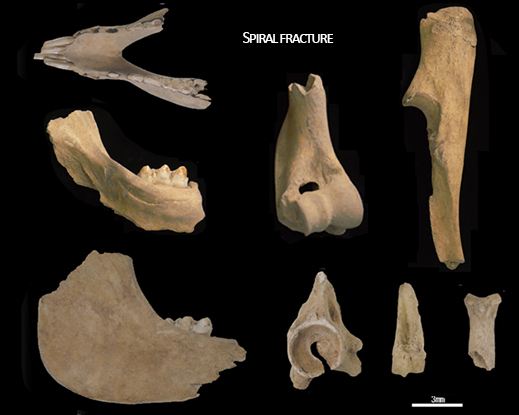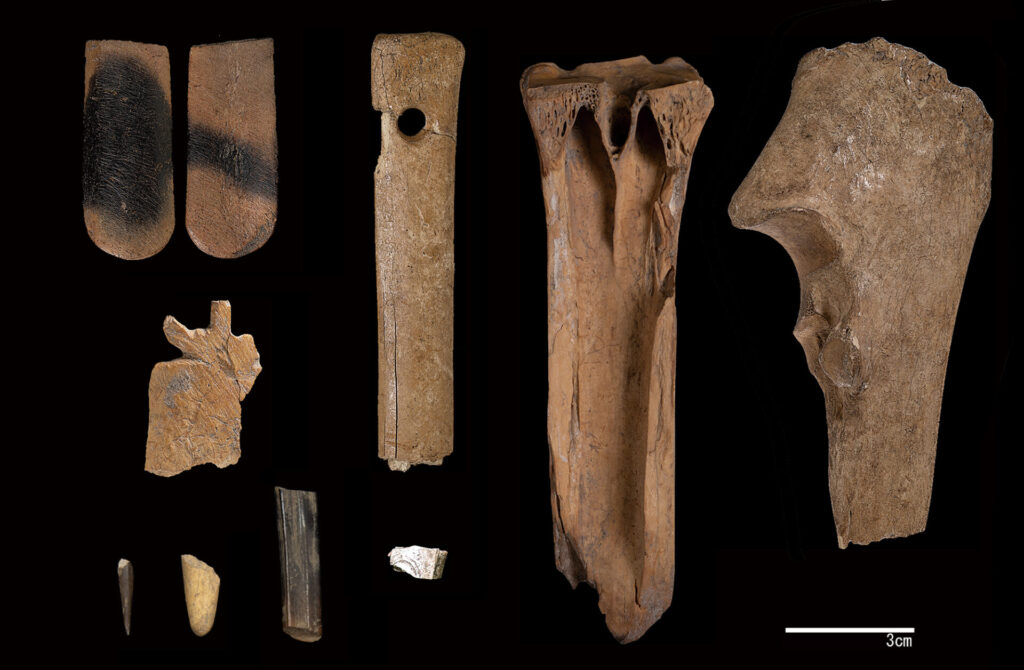Utilization of Animals Based on Faunal Remains
Past studies have demonstrated that the utilization patterns of animals at the Iyai rock shelter site closely resemble those at the Tochibara rock shelter site and the Yugura cave site in Nagano Prefecture, all dating to the same period. This section highlights some findings, primarily from the fourth and fifth excavations.
Faunal Remains Excavated from the Iyai Rock Shelter Site
To ensure comprehensive analysis and avoid overlooking microscopic artifacts, we employed a method that involved visual inspection along with dry sieving and washing the entirety of the excavated soil from the site. Among the 42,267 faunal remains recovered during the fourth and fifth excavations, the Number of Identified Specimens (NISP) totaled 5,158. Specifically, 1,929 were retrieved from within the rock shelter, 3,223 from the slope extending from the terrace, and six from an unidentified area. Notably, approximately 63% of these remains were found in the soil from the slope adjacent to the terrace (Fig. 1).
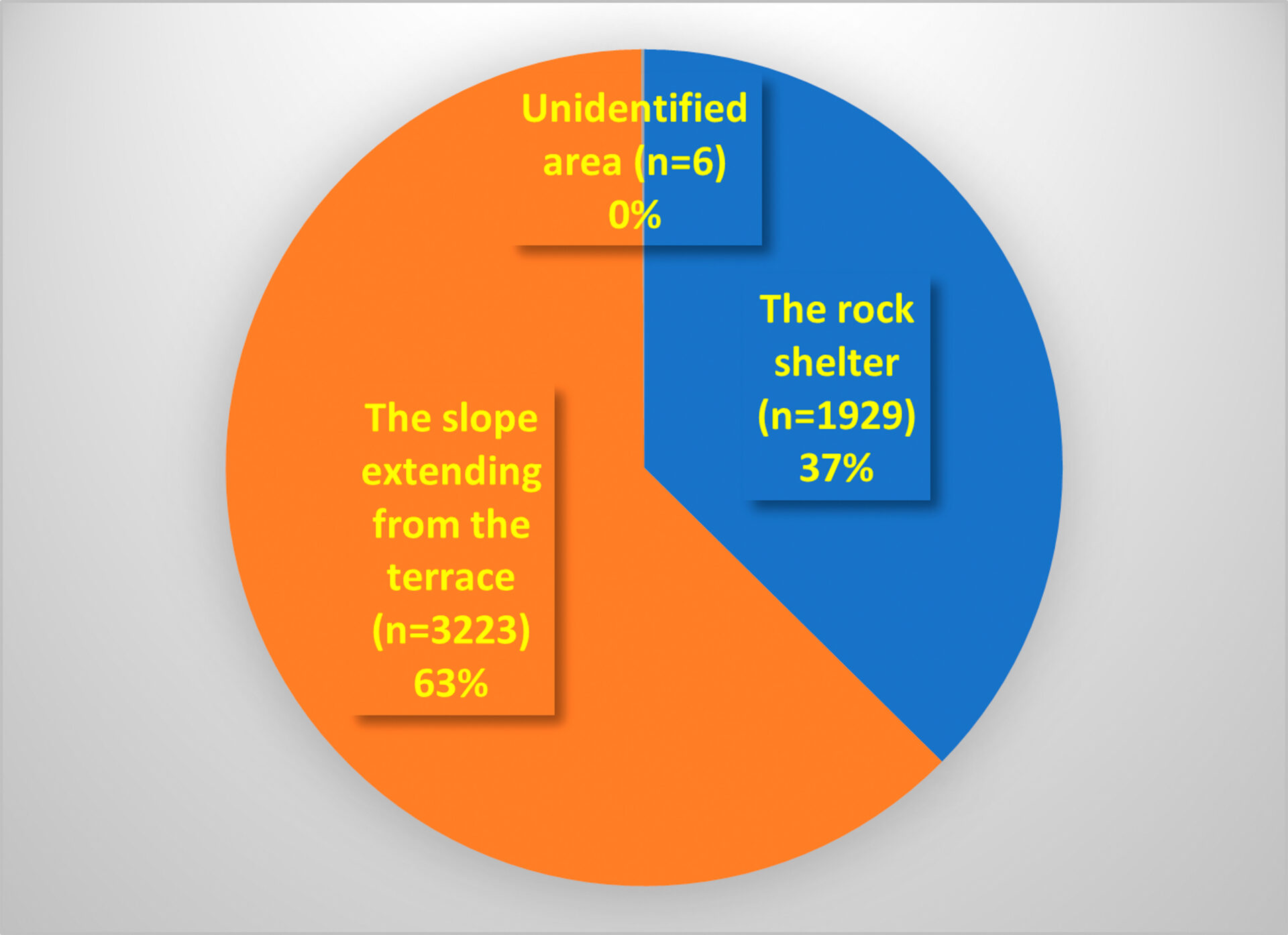
Fig. 1 Percentages of numbers of identified specimens (NISP) from the fourth and fifth excavations.
When categorizing the identified specimens, the breakdown is as follows: 1,900 consist of shellfish (including fragments), 1 is a crustacean, 7 are fish, 404 are amphibians, 4 are reptiles, 485 are birds, 2,328 are mammals, and 30 are vertebrates. Among these findings, mammals were the most prevalent (comprising 71% of the total), excluding shellfish, which included numerous small fragments. Additionally, birds (15%) and amphibians (12%) were frequently encountered. The specimens represented a total of 62 animal species: 15 species from 10 families of Class Gastropoda, 6 species from 5 families of Class Bivalvia, 3 species from 1 family of Order Dentalioida(Class Scaphopoda), 1 species from 1 freshwater crab family, 4 species from 3 fish families, over 3 species from 2 frog families, 1 species from 1 snake family, 7 species from 6 bird families, and 22 species from 13 mammal families. However, the number of species includes the number that could only be identified to the level of genus or family.
Fauna of the Site According to Habitat
When categorized by habitat, approximately nine specimens (constitutingaround 14% of the total identified) were freshwater species, including Semisulcospira libertine (black snails), Margaritifera laevis(freshwater pearl mussels), Order Unionoida(Unionidae), Geothelphusa dehaani?( Japanese Freshwater Crab), the family Cyprinidae (Koi), Cherry Salmon (landlocked salmon), Salmonidae, Anatidae (ducks), Chimarrogale platycephalus (Japanese water shrew), and one specimen (about 2% of the total) was a brackish species. Additionally, nine specimens (approximately 14% of the total) were marine species, comprising Cypraea gracilis? (graceful cowry?), Conidae(corn shells), Anadara(Scapharca) sp.( arkshells) ,Family Arcidae―, Meretrix lusoria(common orient clam), Antalis weinkauffi,, Fissidentalium yokoyamai,, Dentalium (Paraadentalium) octangulatum, and Sphyraenidae. The remaining 43 species (roughly 70% of the total) were terrestrial animals. These findings collectively indicate a diverse fauna spanning various environments (Table 1).
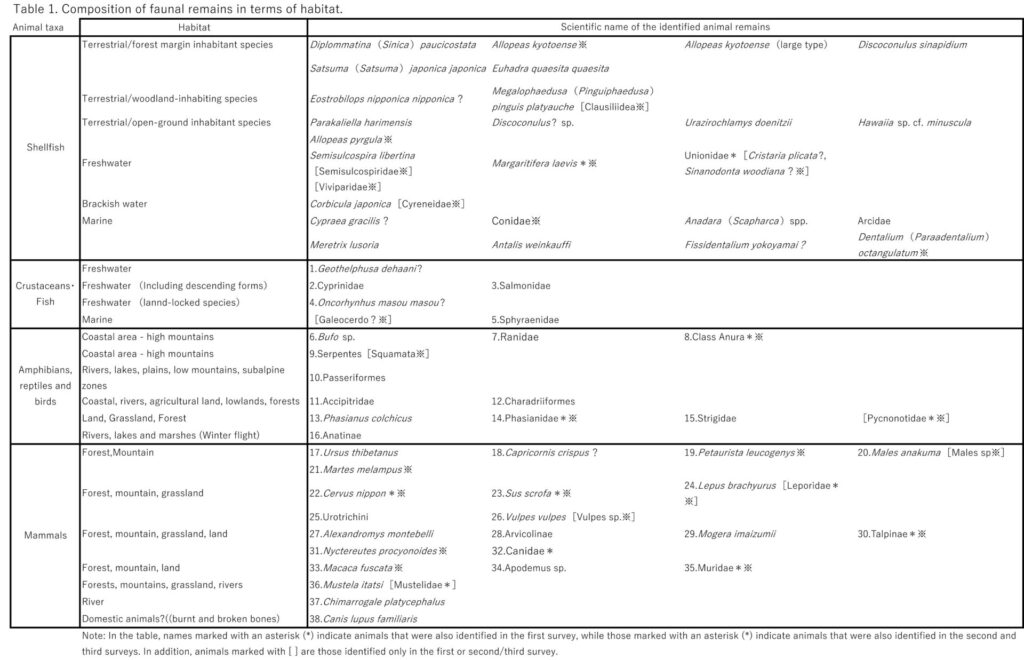
The Most Frequently Utilized Animals and Their Usage
The most frequently utilized animals were Japanese deer and wild boar (see Fig. 2), extensively used by the Jomon people, as almost all the bones from these animals exhibit various traumatic marks (refer to Figures 3 and 4). These marks include a stone arrowhead embedded in a thoracic vertebra of a Japanese deer, spiral fractures (caused during the extraction of marrow from fresh limb bones), cut marks resulting from the severing of muscles and tendons during butchery, evidence of blunt force trauma and peeling during tool production, discoloration from burning by cooking, etc., and bite marks attributed to carnivores and rodents, among other indicators.
Fig. 2 Vertebrate composition of the rock shelter (left: NISP=962)
and the slope leading from the terrace (right: NISP=2296).
Fig. 3 Concentration of animal bone found in the slope leading from the terrace (left)
and thoracic vertebrae of a Japanese deer with an embedded stone arrowhead (right).
Fig. 4 Excavated fragments of Japanese deer (left) and wild boar (right).
The second most abundant species were birds, with more than 80% belonging to Pheasantidae. It is likely that medium-sized Pheasantidae were utilized throughout the year, given their status as resident birds in grasslands and forests. Anatidae, which migrate to inland waterways during winter, were probably utilized seasonally. The third most abundant species were frogs, including toads from the Bufo genus, found in significant numbers on the slope leading from the terrace, especially in strata 10, accounting for 73% of the total fauna species excavated. At the Tochibara rock shelter site, large numbers of toad remains were discovered in soil dating to the first half of the Initial Jomon period, presumably indicating their use as food. Similarly, toad remains from the Iyai rock shelter site exhibit signs of heating, suggesting their consumption by the inhabitants. Small mammals such as true amphibians and rodents, approximately the size of mice, also show evidence of exposure to heat, implying the utilization of a wide variety of animals, including smaller species, by the populations at the Iyai site. Despite the nearby Shirasuna River and the discovery of fish hooks and unfinished tools, only a small number of fish remains, totaling 7, were found. Carbon-nitrogen stable isotope analysis of the human skeletal remains aligns with the notion that terrestrial animals constituted the main food source of the people from the Iyai rock shelter site, with minimal reliance on marine products. However, it’s noteworthy that a remain from chum salmon(Oncorhynchus sp.), previously abundant at the Yugura Cave site and the Tochibara Rock Shelter site on the Chikuma River system, were also excavated at the Iyai site on the Tone River system. This suggests potential future discoveries (Fig. 5).”
Figure 5. Shellfish, fish and amphibians (left) and birds, small and medium-sized mammals (right)
Characteristics of the Marine and Brackish Water Animals and Products Brought into the Site
The notably high proportion of marine and brackish water species (approximately 16%) at this site stands out as a significant feature. The marine shellfish species, except for the graceful cowry? (Cypraea gracilis?) and common orient clams(Meretrix lusoria)which were both fragments, were all processed products. This includes the jawbone of a fish from the barracuda family(Sphyraenidae), measuring over 1 meter in length, which showed signs of being worked on. During the second and third excavations of the site, a tooth from a tiger shark(Galeocerdo sp.) was discovered. Remains of marine animals have also been found at the Tochibara rock shelter site (processed shortfin mako teeth) and at the Yugura cave site (flatfish vertebrae). At the Iyai rock shelter site, most marine artifacts were excavated from inside the rock shelter, suggesting the possibility that they were brought in to be used as burial goods.
Shellfish products (216) and bone horn and tusk tools (97) were also excavated (refer to Fig. 6), but the most prevalent items were beads. Particularly noteworthy were fossilized Fissidentalium yokoyamai shells, believed to have originated from the Miura Peninsula in Kanagawa Prefecture. Radiometric dating at the Tochibara rock shelter site revealed tuskshells dating back more than 40,000 years. There is evidence of fossil use at the Iyai rock shelter site as well. Moreover, the discovery of graceful cowry? (Cypraea gracilis?) confirms the ‘set of three species of tusk mussels, cowrie mussels, and cone shells’ of the Initial Jomon period proposed by Taiji Kurozumi et al. at this site.As described above, it has become evident that the lifestyle of the populations inhabiting the Iyai rock shelter site was similar to that of the Tochibara rock shelter and Yugura cave sites. Further research on the subsistence occupation of the site will be conducted in the future.”
Fig. 6 Shellfish products (left) and bone horn and tusk tools (right)
Kyomi Yamazaki
Taiji Kurozumi
Masaki Eda
